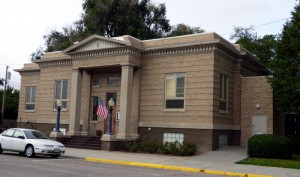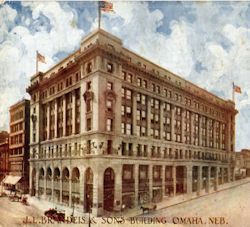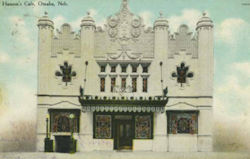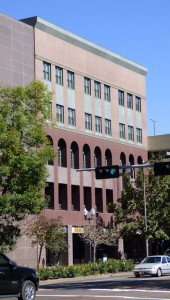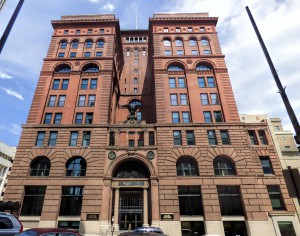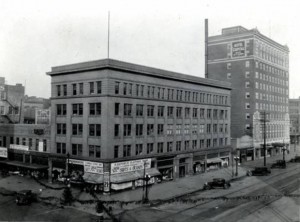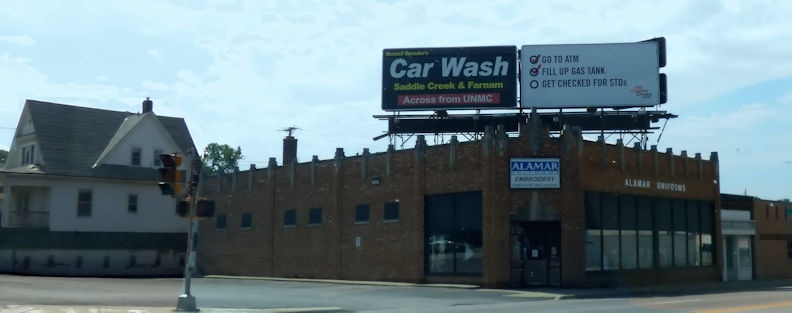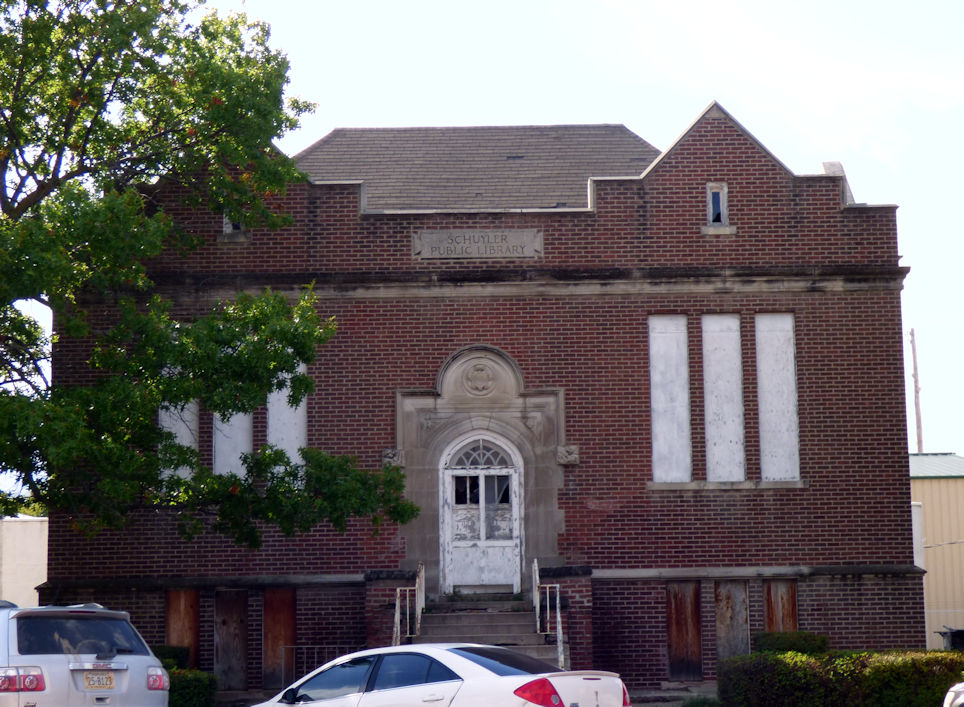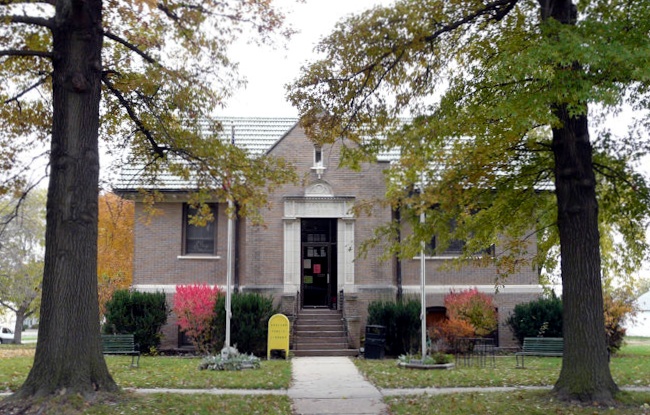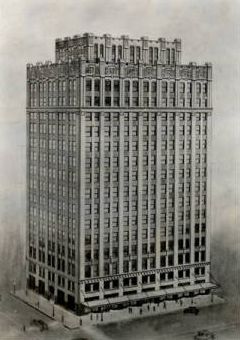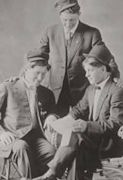Search the Blog
Categories
- Books & Reading
- Broadband Buzz
- Census
- Education & Training
- Friday Reads
- General
- Grants
- Information Resources
- Library Management
- Nebraska Center for the Book
- Nebraska Libraries on the Web
- Nebraska Memories
- Now hiring @ your library
- Preservation
- Pretty Sweet Tech
- Programming
- Public Library Boards of Trustees
- Public Relations
- Talking Book & Braille Service (TBBS)
- Technology
- Uncategorized
- What's Up Doc / Govdocs
- Youth Services
Archives
Subscribe
Author Archives: Allana Novotny
“Nee-bras-ki is where we dwell”
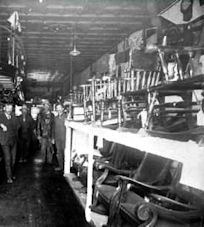 Nebraska Memories contains 5,500+ digitized items from institutions across Nebraska. I’ve been working with the project since it began and I think I’ve seen every item in the collection at least once or twice. Not surprisingly, I’m drawn to some items more than other items. I wanted to share with you a few of the items that I like.
Nebraska Memories contains 5,500+ digitized items from institutions across Nebraska. I’ve been working with the project since it began and I think I’ve seen every item in the collection at least once or twice. Not surprisingly, I’m drawn to some items more than other items. I wanted to share with you a few of the items that I like.
I’ll start with the picture of McNair Hardware that was taken in Crawford. The quality of the picture isn’t that great but I love the rows of rocking chairs. My parents own a rocking chair very similar to the padded chair on the bottom shelf. When I look at this photo, I always see it as an antique store until I remember that this photo was taken in 1909 and these are probably new chairs for sale.
 Included in Nebraska Memories is a collection of 256 musical scores from the Polley Music Library. I haven’t made the time to read the lyrics of every song in the collection but I’ve read a few. The lyrics of the song Nebraska, written by B. A. Rosencrans of Plattsmouth, Nebraska, always makes me laugh, especially the chorus. This song was written in 1927 and was dedicated to the American Legion Posts of Nebraska. I’ll tease you by just including the chorus below. You can view the complete score on the Nebraska Memories website. I’m assuming the name Volstead in the third verse is referring to the Volstead Act, which is actually a nickname for the National Prohibition Act.
Included in Nebraska Memories is a collection of 256 musical scores from the Polley Music Library. I haven’t made the time to read the lyrics of every song in the collection but I’ve read a few. The lyrics of the song Nebraska, written by B. A. Rosencrans of Plattsmouth, Nebraska, always makes me laugh, especially the chorus. This song was written in 1927 and was dedicated to the American Legion Posts of Nebraska. I’ll tease you by just including the chorus below. You can view the complete score on the Nebraska Memories website. I’m assuming the name Volstead in the third verse is referring to the Volstead Act, which is actually a nickname for the National Prohibition Act.
 Nebraska chorus:
Nebraska chorus:
“Nee-bras-ki,” That’s its name;
Cows and corn have won it fame.
Nee-bras-ki is where we dwell,
Its the best old state this side of.
On the last page of the score, they included the text that you see in the image on the right. One line states that this “It will be to Nebraska what the “Corn Song” is to Iowa.” I’ve never heard of the Corn Song before so I did a quick search and found the score on the Iowa Digital Library website. I wonder if Mr. Rosencrans wrote Nebraska as Nee-bras-ki because Iowa was written and I-O-Way in the Corn Song.
 Another set of photos that intrigues me are those of the clowns and actors at Camp Atlanta. If you are not familiar with Camp Atlanta, it was a German P.O.W camp located about 10 miles southwest Holdrege. It was in use from 1943 to 1946.
Another set of photos that intrigues me are those of the clowns and actors at Camp Atlanta. If you are not familiar with Camp Atlanta, it was a German P.O.W camp located about 10 miles southwest Holdrege. It was in use from 1943 to 1946.
 I’m sure we have all seen a TV show or movie where they are in a grocery store and the cans are stacked high in some pyramid type shape until someone either runs into the stack or pulls out the wrong can. While it makes for great entertainment, I don’t remember ever seeing stacks like this in any of the stores I frequent. Maybe that’s why I like this food display in the California Grocery. If you wanted to take advantage of the sale on apricots and buy three cans for 59 cents, which three cans would you pick up?
I’m sure we have all seen a TV show or movie where they are in a grocery store and the cans are stacked high in some pyramid type shape until someone either runs into the stack or pulls out the wrong can. While it makes for great entertainment, I don’t remember ever seeing stacks like this in any of the stores I frequent. Maybe that’s why I like this food display in the California Grocery. If you wanted to take advantage of the sale on apricots and buy three cans for 59 cents, which three cans would you pick up?
 A list of favorites wouldn’t be complete unless it included pictures of children reading, a cat, and a baby playing with a dog.
A list of favorites wouldn’t be complete unless it included pictures of children reading, a cat, and a baby playing with a dog.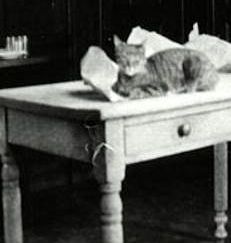
These are just a few my favorite items in Nebraska Memories. Do you have any favorites? Visit Nebraska Memories to search for or browse through many more historical images digitized from photographs, negatives, postcards, maps, lantern slides, books and other materials.
 Nebraska Memories is a cooperative project to digitize Nebraska-related historical and cultural heritage materials and make them available to researchers of all ages via the Internet. Nebraska Memories is brought to you by the Nebraska Library Commission. If your institution is interested in participating in Nebraska Memories, see http://nlc.nebraska.gov/nebraskamemories/participation.aspx for more information, contact Devra Dragos, Technology & Access Services Director.
Nebraska Memories is a cooperative project to digitize Nebraska-related historical and cultural heritage materials and make them available to researchers of all ages via the Internet. Nebraska Memories is brought to you by the Nebraska Library Commission. If your institution is interested in participating in Nebraska Memories, see http://nlc.nebraska.gov/nebraskamemories/participation.aspx for more information, contact Devra Dragos, Technology & Access Services Director.
The Modern Farm Horse
 As the harvest season is ending, I thought it would be a great time to look at some of the first tractors Nebraskans used to work the fields. Looking at the photos in Nebraska Memories makes me wonder what people thought of these large metal machines as they started to be delivered to farms across the state. Someone in Sidney cared enough to have a photo taken of a railroad flat car loaded with three International Harvester Mogul steam tractors. You can see how large the tractors are compared to the men standing in front of them.
As the harvest season is ending, I thought it would be a great time to look at some of the first tractors Nebraskans used to work the fields. Looking at the photos in Nebraska Memories makes me wonder what people thought of these large metal machines as they started to be delivered to farms across the state. Someone in Sidney cared enough to have a photo taken of a railroad flat car loaded with three International Harvester Mogul steam tractors. You can see how large the tractors are compared to the men standing in front of them.
 Photographer John Nelson took a picture of man who I consider to be brave. The man is standing on the back of a tractor that appears to be part way up a ramp with a sharp incline. The tractor must have great breaks since it is not rolling down the incline.
Photographer John Nelson took a picture of man who I consider to be brave. The man is standing on the back of a tractor that appears to be part way up a ramp with a sharp incline. The tractor must have great breaks since it is not rolling down the incline.
John Nelson also took a picture of a group of six men standing next to a tractor in what appears to be the middle of a field. While we may never know what was really going on at the time of this picture it appears to me that they got the tractor and the cart they were pulling stuck in the mud. As you can see, the back wheels of the tractor and the wagon wheels are almost axel deep in mud. You have to wonder if the tractor made it out on its own steam or if the men and/or horses in the picture had to help.
the tractor and the cart they were pulling stuck in the mud. As you can see, the back wheels of the tractor and the wagon wheels are almost axel deep in mud. You have to wonder if the tractor made it out on its own steam or if the men and/or horses in the picture had to help.
If you haven’t noticed, I don’t know much about tractors. When I saw the photo of the Hart-Parr Company, I just assumed it was a local company in Lincoln. I love the sign next to the garage door. It states “The modern farm horse. Does plowing for 40 to 60 cents per acre. eats nothing when idle”. 
I originally planned to do a bit of research to see if I could learn something about this local company. I was surprised to learn however that the Hart-Parr Company was actually a tractor company based out of Charles City Iowa. I can only assume that the location in Lincoln was the local dealership. If you are a tractor enthusiast, you may be interested to know that Hart-Parr merged with three other companies in 1929 to form the Oliver Farm Equipment Company. The Oliver Company went through some changes and finally ended up being White Farm Equipment.
 One of the place I looked for information about the Hart-Parr Company was in the Library of Congress’s Chronicling America: Historic American Newspapers collection. While I
One of the place I looked for information about the Hart-Parr Company was in the Library of Congress’s Chronicling America: Historic American Newspapers collection. While I  didn’t find the type of information I was hoping to find I did run across a couple of fun ads that appeared in The Commoner. In 1912 the Hart-Parr Company offered a correspondence course that would teach you how to run a tractor. Participants in the course also got to attend the practice schools where they could “actually run a tractor”. One of these schools was located in Lincoln.
didn’t find the type of information I was hoping to find I did run across a couple of fun ads that appeared in The Commoner. In 1912 the Hart-Parr Company offered a correspondence course that would teach you how to run a tractor. Participants in the course also got to attend the practice schools where they could “actually run a tractor”. One of these schools was located in Lincoln.
I hoped you enjoyed seeing some of these “Modern Farm Horse”. Visit Nebraska Memories to search for or browse through many more historical images digitized from photographs, negatives, postcards, maps, lantern slides, books and other materials.
Nebraska Memories is a cooperative project to digitize Nebraska-related historical and cultural heritage materials and make them available to researchers of all ages via the Internet. Nebraska Memories is brought to you by the Nebraska Library Commission. If your institution is interested in participating in Nebraska Memories, see http://nlc.nebraska.gov/nebraskamemories/participation.aspx for more information, contact Devra Dragos, Technology & Access Services Director.
Nebraska Then and Now Part 2
Last month I wrote a post that showed 15 historical images of buildings that are part of the Nebraska Memories collection and are still standing today. As I mentioned, I’ve tried to take pictures of some of these historical buildings as I’ve traveled the state because I thought it would be fun to see how much or how little these buildings have changed. As I was going through my collection of photos I realized I had enough photos for at least one more post showing what Nebraska looked like then and now.
I hope you enjoy looking at these pictures to see how these buildings have and have not changed over the years.
Albion Public Library in Nebraska – 437 S 3rd St, Albion
Public Library, Alliance, Neb. – 204 W 4th St, Alliance
Burlington Station, Omaha, Neb. – 926 S. 10th Street, Omaha

Picture: 2015
Read about how the Burlington Station is being remolded.
Burlington Station – 925 S. 10th Street, Omaha

Picture: 2015
The columns were removed from the Burlington Station during a renovation in 1930. The columns are now located on the UNL Campus near Memorial Stadium.
Hardy’s Furniture Building – 1314 O Street, Lincoln
J. L. Brandeis & Sons Building, Omaha, Neb. – 16th and Douglas Streets, Omaha
Library building, McCook413 Norris Ave, McCook
Nash Building – 16th and Harney Streets, Omaha
Ponca Public Library in Nebraska – 203 2nd St, Ponca
Scottish Rite Cathedral, Omaha, Neb. – 20th & Douglas Streets, Omaha
Farnam St. looking east, Omaha, Nebr. – Farnam Street looking east from 18th Street, Omaha
Hanson’s Cafe, Omaha, Neb. – 315 S. 16th Street, Omaha
Rose Building and Henshaw Hotel, 16th & Farnam Sts., Omaha, Neb. – 16th & Farnam St., Omaha
Mitchell Mercantile – 13th & Center Ave, Mitchell
Hotel Hill, Omaha, Nebraska – 505 South 16th Street, Omaha
Hardy’s Furniture Building – 1314 O Street, Lincoln
Dodge County Courthouse construction, Fremont, Nebraska – 435 N Park Ave
New York Life Ins. Bld., Omaha, Neb. – 17th & Farnam Streets, Omaha
Visit Nebraska Memories to search for or browse through many more historical images digitized from photographs, negatives, postcards, maps, lantern slides, books and other materials.
Nebraska Memories is a cooperative project to digitize Nebraska-related historical and cultural heritage materials and make them available to researchers of all ages via the Internet. Nebraska Memories is brought to you by the Nebraska Library Commission. If your institution is interested in participating in Nebraska Memories, see http://nlc.nebraska.gov/nebraskamemories/participation.aspx for more information, contact Devra Dragos, Technology & Access Services Director.
Posted in General, Nebraska Memories, Technology
Leave a comment
Nebraska Then and Now
When looking at pictures of historical buildings in Nebraska Memories I’m always surprised at how many buildings and places I recognize. Many of these buildings have been around for 100 years and are still being used today. Over the years, as I’ve traveled across the state, I’ve tried to take pictures of some of these historical buildings because I thought it would be fun to see how much or how little these buildings have changed.
As I’ve taken pictures of these buildings there are a few things that I have noticed. First of all there is a lot less clutter in the historical photos. Today many of the pictures I’ve taken are full of stop lights, street signs, and electrical lines. Also it appears that we have planted a lot of trees over the past 100 or so years. I like trees. I think it’s great we have planted so many but it really makes it hard to take a picture of a building when it is surrounded by trees. The last thing I’ve noticed as I’ve looked at the old photos is angle from which the photos were taken from. The photographers were either able to stand further away from the buildings or they had access to a neighboring building and took the picture out the window or from the rooftop. Also you can only move so far back when you are standing on a street corner in downtown Omaha surrounded by tall buildings.
I hope you enjoy looking at these pictures to see how some of these buildings have and have not changed over the years. Click on an old picture to learn more about the building. Click on the new picture to see a larger version of the new picture.
Flat Iron Building – 17th, St. Mary’s, Howard, and 18th Streets, Omaha
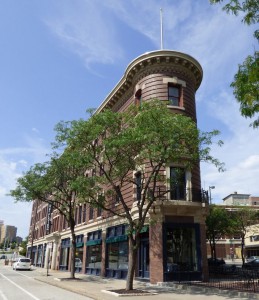
Picture: 2015
Read about the recent renovations to this building.
Omaha Public Library – 19th and Harney Streets, Omaha
Little Building – 11th and O Streets, Lincoln
Omaha High School – 20th and Dodge St, Omaha
Mitchell High School – 19th Ave and 18th St, Mitchell
Exterior of Glidden Paints building – 31st and Leavenworth St, Omaha
Public Library, Schuyler, Nebr. – E 10th and C Streets, Schuyler
Post office, South Omaha, Neb. – S 24th and M Streets, Omaha
Donley Stahl Building – 13th and N Street, Lincoln
Carnegie Library, Ashland – N 15th and Boyd Streets, Ashland
Pavilion at Miller Park – Millier Park Drive, Omaha
Keeline Building – 17th & Harney Streets, Omaha
Sharp Building – 13th and N Street, Lincoln
Security Mutual Building – 12th and O Streets, Lincoln
First National Bank – 16th and Farnam Streets, Omaha
Visit Nebraska Memories to search for or browse through many more historical images digitized from photographs, negatives, postcards, maps, lantern slides, books and other materials.
Nebraska Memories is a cooperative project to digitize Nebraska-related historical and cultural heritage materials and make them available to researchers of all ages via the Internet. Nebraska Memories is brought to you by the Nebraska Library Commission. If your institution is interested in participating in Nebraska Memories, see http://nlc.nebraska.gov/nebraskamemories/participation.aspx for more information, contact Devra Dragos, Technology & Access Services Director.
Posted in General, Nebraska Memories, Technology
3 Comments
Nebraska 125 Years Ago – Part 2
In my blog post last week I talked about Nebraska 125 years ago and want to continue with that topic. This week we will take a look at the towns of Fremont, Brainard, Fairmont, Bertrand and Sidney.
 Fremont was still a relatively small town with a population of just 1,195. It 1890 it was only 19 years old as it was founded in 1871. Looking at the photo of the Zach Shed residence however it appears that they had some very nice looking houses in town at that time. The Shed residence is ornate as it was built in the Gothic Revival style. While the streets appear to be dirt, the sidewalk surrounding the house is wood. The wood sidewalks even appear to continue across the street.
Fremont was still a relatively small town with a population of just 1,195. It 1890 it was only 19 years old as it was founded in 1871. Looking at the photo of the Zach Shed residence however it appears that they had some very nice looking houses in town at that time. The Shed residence is ornate as it was built in the Gothic Revival style. While the streets appear to be dirt, the sidewalk surrounding the house is wood. The wood sidewalks even appear to continue across the street.
 Brainard is just a few years younger than Fremont as it was settled in 1878. The population of Brainard appears to have remained fairly steady over time. In 1890 the population was 306. According to the 2010 Census the population of Brainard was 330. The Smersh Hardware store was established in town on 1884 by Jakub Smersh. While we don’t know the names of the gentlemen standing in front of the store, I would like to think one of the nicely dressed men in a suit, tie and hat is Jakub.
Brainard is just a few years younger than Fremont as it was settled in 1878. The population of Brainard appears to have remained fairly steady over time. In 1890 the population was 306. According to the 2010 Census the population of Brainard was 330. The Smersh Hardware store was established in town on 1884 by Jakub Smersh. While we don’t know the names of the gentlemen standing in front of the store, I would like to think one of the nicely dressed men in a suit, tie and hat is Jakub.
 The town of Fairmont appears to have been prosperous in 1890 as it was able to support the Price elevator. At the time the population of town was 1,029. According to the note of the photo the Price elevator stood on the site of the present day elevator in town. The Farmers Cooperative Association purchased the elevator in 1919.
The town of Fairmont appears to have been prosperous in 1890 as it was able to support the Price elevator. At the time the population of town was 1,029. According to the note of the photo the Price elevator stood on the site of the present day elevator in town. The Farmers Cooperative Association purchased the elevator in 1919.
 The 1890 photo of Eichelberger store on Main Street, Bertrand, Nebraska provides us with a great view of downtown. For a town of just 265 people it appears to have a large and active main street.
The 1890 photo of Eichelberger store on Main Street, Bertrand, Nebraska provides us with a great view of downtown. For a town of just 265 people it appears to have a large and active main street.
Rose Street in Sidney also appears to be very busy in 1890. Sidney is the oldest of the five towns I’ve mentioned. It was founded in 1867. Looking at the picture of the west side of Rose Street you can see many different types of businesses including multiple grocery stores, a restaurant, arcade, and a meat market.  You could even stop in to Doran & Tobin for a beer as their sign clearly states that they are “agents for Anheuser Busch Beer”.
You could even stop in to Doran & Tobin for a beer as their sign clearly states that they are “agents for Anheuser Busch Beer”.
I hope you enjoyed seeing what Nebraska was like 125 years ago. Visit Nebraska Memories to search for or browse through many more historical images digitized from photographs, negatives, postcards, maps, lantern slides, books and other materials.
Nebraska Memories is a cooperative project to digitize Nebraska-related historical and cultural heritage materials and make them available to researchers of all ages via the Internet. Nebraska Memories is brought to you by the Nebraska Library Commission. If your institution is interested in participating in Nebraska Memories, see http://nlc.nebraska.gov/nebraskamemories/participation.aspx for more information, contact Devra Dragos, Technology & Access Services Director.
Posted in General, Nebraska Memories, Technology
Leave a comment
Nebraska 125 Years Ago – Part 1
 The year was 1890 and Nebraska had officially been a state for 23 years. John Milton Thayer was Governor. The population of the state was 1.062 million but the population of Lincoln was just 55,154. Lincoln was being protected by Chief Melick and his fellow Lincoln police officers.
The year was 1890 and Nebraska had officially been a state for 23 years. John Milton Thayer was Governor. The population of the state was 1.062 million but the population of Lincoln was just 55,154. Lincoln was being protected by Chief Melick and his fellow Lincoln police officers.
 The University of Nebraska held their Nineteenth annual commencement on June 11, 1890. The commencement was held at Funke’s Opera House which was located at the corner of 12th & O Streets in Lincoln. It had formerly been called Hallo’s Opera House and then Centennial Opera House. According to the commencement program the Governor attended the ceremony to present the military commissions.
The University of Nebraska held their Nineteenth annual commencement on June 11, 1890. The commencement was held at Funke’s Opera House which was located at the corner of 12th & O Streets in Lincoln. It had formerly been called Hallo’s Opera House and then Centennial Opera House. According to the commencement program the Governor attended the ceremony to present the military commissions.
 Omaha was also a lot smaller in 1890 with a population of 140,452. The city had a number of paved streets at this time as can be seen on this 1890 Paving map of Omaha, Nebraska. To get a better idea of the physical size of Omaha I studied the map looking for landmarks that are still present 125 years later. The east side of Omaha of course is easy to identify. On the North half of the map Cut Off Lake is clearly marked. If you don’t recognize that lake it may be because in 1906 the name was changed to Carter Lake. On the South half of the map the Missouri River is clearly marked. The northern edge of town is also fairly easy to identify. Towards the top of the North half of the map you can clearly see Fort Omaha. It’s located near where the top fold line and middle fold line on the map cross.
Omaha was also a lot smaller in 1890 with a population of 140,452. The city had a number of paved streets at this time as can be seen on this 1890 Paving map of Omaha, Nebraska. To get a better idea of the physical size of Omaha I studied the map looking for landmarks that are still present 125 years later. The east side of Omaha of course is easy to identify. On the North half of the map Cut Off Lake is clearly marked. If you don’t recognize that lake it may be because in 1906 the name was changed to Carter Lake. On the South half of the map the Missouri River is clearly marked. The northern edge of town is also fairly easy to identify. Towards the top of the North half of the map you can clearly see Fort Omaha. It’s located near where the top fold line and middle fold line on the map cross.
 The south edge of town is also easy to identify. On the bottom right corner of the South half of the map is River View Park. If you don’t know the history of River View Park it is now the location of the Henry Doorly Zoo. Locating a present day landmark on the far west side of Omaha wasn’t as easy. Looking at the map you will see that there are very few of the north south streets are named and when are named they don’t always match up with current street names. On the South half of the map Hanscom Park is located at about the center of the map. The west side of the park runs along 32nd Ave. I’m guessing the west side of town ends around what is now 50th street.
The south edge of town is also easy to identify. On the bottom right corner of the South half of the map is River View Park. If you don’t know the history of River View Park it is now the location of the Henry Doorly Zoo. Locating a present day landmark on the far west side of Omaha wasn’t as easy. Looking at the map you will see that there are very few of the north south streets are named and when are named they don’t always match up with current street names. On the South half of the map Hanscom Park is located at about the center of the map. The west side of the park runs along 32nd Ave. I’m guessing the west side of town ends around what is now 50th street.
 Looking at the map you can see that the streets of Omaha in 1890 were paved with a variety of different materials, including sheet asphalt, Sioux Falls granite, Colorado sandstone, Woodruff sandstone, Galesburg brick, cedar block, and cypress block. Looking at the area of 13th and Jones Street you can see that a variety of these options were used in this area. While the map does not label individual stores we know that Henry Moeller’s grocery store was located on the northwest corner of 13th and Jones.
Looking at the map you can see that the streets of Omaha in 1890 were paved with a variety of different materials, including sheet asphalt, Sioux Falls granite, Colorado sandstone, Woodruff sandstone, Galesburg brick, cedar block, and cypress block. Looking at the area of 13th and Jones Street you can see that a variety of these options were used in this area. While the map does not label individual stores we know that Henry Moeller’s grocery store was located on the northwest corner of 13th and Jones. Looking at the picture I think the store faced Jones Street but unfortunately I can’t tell if that is Sioux Falls granite in front of the store.
Looking at the picture I think the store faced Jones Street but unfortunately I can’t tell if that is Sioux Falls granite in front of the store.
Watch for Nebraska 125 Years Ago, Part 2 next week to see more of Nebraska and what it looked in 1890.
Visit Nebraska Memories to search for or browse through many more historical images digitized from photographs, negatives, postcards, maps, lantern slides, books and other materials.
Nebraska Memories is a cooperative project to digitize Nebraska-related historical and cultural heritage materials and make them available to researchers of all ages via the Internet. Nebraska Memories is brought to you by the Nebraska Library Commission. If your institution is interested in participating in Nebraska Memories, see http://nlc.nebraska.gov/nebraskamemories/participation.aspx for more information, contact Devra Dragos, Technology & Access Services Director.
Posted in General, Nebraska Memories, Technology
Leave a comment
What did it really look like?
It seems like every few weeks a news story about a photo of a model or celebrity being retouched makes the rounds. The topic of photo manipulation or retouching is not new but did you realize that the manipulation of images has been going on since the 1800’s? I don’t know a lot about how this early manipulation was done but they used many techniques including hand-coloring black and white photos and negatives and combining pieces of multiple pictures and negatives to create a new image. What I do know is that there are many great examples of postcards in Nebraska Memories that feature images that have been manipulated.
What I do know is that there are many great examples of postcards in Nebraska Memories that feature images that have been manipulated.
Let’s start by looking at an obvious manipulation. This postcard is captioned “Fishing on Pibel Lake, Nebraska”. Look at the size of that fish. It is almost as big as the boat. If you want to try catching a big a fish like that you can visit Pibel Lake as it is a Nebraska State Recreation Area. (Update – The Pibel Lake Recreation Area is now owned by the Lower Loup Natural Resources District)
 Looking at this postcard captioned “Among the cattle pens, stock yards, South Omaha, Neb.” you can see that color has been added but I think they got something wrong. Have you ever seen healthy green vegetation growing in an active stockyard? Growing up I drove past these stockyards many times. I don’t remember them ever being this lush and green looking when they were filled with cattle.
Looking at this postcard captioned “Among the cattle pens, stock yards, South Omaha, Neb.” you can see that color has been added but I think they got something wrong. Have you ever seen healthy green vegetation growing in an active stockyard? Growing up I drove past these stockyards many times. I don’t remember them ever being this lush and green looking when they were filled with cattle.
Sometimes looking at a single postcard you may realize that color has been added unless you can compare it to the original black and white image or you notice something odd you may think the coloring looks good. It would be fun if we could compare the original image to the enhanced version but unfortunately we don’t have that option. In Nebraska Memories we do however have multiple postcards of the same scenes.
There are two postcards in Nebraska Memories captioned “Partial view of stock yards, South Omaha”. One is black and white while the other one has had color added. Looking at these postcards is a great way to see how adding color changes an image.
These next two postcards appear to be created from the exact same image however the manipulation that was done to them is slightly different. The postcards are captioned Stock pens, South Omaha, Neb. and Stock pens, south side, Omaha, Neb.. Some of the differences between these two postcards are obvious such as making the roofs have a reddish cast to them. Also the postcard on the top has an overcall darker feel to it. 
 To see these next differences you may need use to above links to look at the actual items in Nebraska Memories where you will be able to zoom in on the postcards. Starting at the bottom left on the postcards do you see the animals in the pen? On one postcard they clearly look like pigs while on the other they look like black blobs. Moving to the right do you see the man standing behind the cattle? On the postcard with the pigs that you can see you will notice that the man is carrying some type of stick over his shoulder while on the other postcard the stick has been colored black and it blends in with the cattle. Next follow the fencing until you locate the man standing on top of the fence. Do you see that there is a tall object next to the man that has been removed from one of the postcards? The last differences I want to point out are the color of the taller fence posts next to the train cars. On one postcard the tops of the posts were left white while the train cars around them were colored. On the other card the posts were colored to match the train cars.
To see these next differences you may need use to above links to look at the actual items in Nebraska Memories where you will be able to zoom in on the postcards. Starting at the bottom left on the postcards do you see the animals in the pen? On one postcard they clearly look like pigs while on the other they look like black blobs. Moving to the right do you see the man standing behind the cattle? On the postcard with the pigs that you can see you will notice that the man is carrying some type of stick over his shoulder while on the other postcard the stick has been colored black and it blends in with the cattle. Next follow the fencing until you locate the man standing on top of the fence. Do you see that there is a tall object next to the man that has been removed from one of the postcards? The last differences I want to point out are the color of the taller fence posts next to the train cars. On one postcard the tops of the posts were left white while the train cars around them were colored. On the other card the posts were colored to match the train cars.
 Finally I want to highlight a selection of postcards picturing the Old City Hall and Bee Building. The Old City Hall building was located on the northeast corner 18th & Farnam Streets. The Bee Buidling stood next to it. Both buildings were torn down in 1966 to make way from the Woodmen Tower. Shown here are just a few of the postcards in Nebraska Memories that feature both of these buildings. After looking at all of these postcards I wonder what these buildings really looked like. Because these buildings were not torn down until early in 1966 I would think that there is a color photo of one or both of these buildings available someplace. If you have a color photo of either of these building stashed away or you know where I can see a color photo I would love to see them!
Finally I want to highlight a selection of postcards picturing the Old City Hall and Bee Building. The Old City Hall building was located on the northeast corner 18th & Farnam Streets. The Bee Buidling stood next to it. Both buildings were torn down in 1966 to make way from the Woodmen Tower. Shown here are just a few of the postcards in Nebraska Memories that feature both of these buildings. After looking at all of these postcards I wonder what these buildings really looked like. Because these buildings were not torn down until early in 1966 I would think that there is a color photo of one or both of these buildings available someplace. If you have a color photo of either of these building stashed away or you know where I can see a color photo I would love to see them!
Visit Nebraska Memories to search for or browse through many more historical images digitized from photographs, negatives, postcards, maps, lantern slides, books and other materials.
Nebraska Memories is a cooperative project to digitize Nebraska-related historical and cultural heritage materials and make them available to researchers of all ages via the Internet. Nebraska Memories is brought to you by the Nebraska Library Commission. If your institution is interested in participating in Nebraska Memories, see http://nlc.nebraska.gov/nebraskamemories/participation.aspx for more information, or contact Beth Goble, Historical Projects Librarian, or Devra Dragos, Technology & Access Services Director.
Posted in General, Information Resources, Nebraska Memories, Technology
2 Comments
Thanks for your help!
 You may remember earlier this year we asked for help in transcribing two autograph albums in Nebraska Memories that belonged to May Martin Ellis and her husband John Ellis. The project was a great success and it only took one week for both albums to be transcribed. We want to thank everyone who helped make this project a success.
You may remember earlier this year we asked for help in transcribing two autograph albums in Nebraska Memories that belonged to May Martin Ellis and her husband John Ellis. The project was a great success and it only took one week for both albums to be transcribed. We want to thank everyone who helped make this project a success.
For those of you not familiar with the project these albums contain many pages of handwritten inscriptions. Some are easy to read while  others take a bit more effort to decipher. Transcribing the handwriting makes it easier to read the inscriptions and makes the albums searchable. As you read the transcriptions remember we did our best to type the text as it was written and did not fix any of errors. This means you will find phrases such as “always paddle your one cenue” and “In the depth of thine- Effeetiend[?] , please plant a sweat Fore-get me not.” The question mark in the brackets means that we were unable to clearly read the handwriting and typed our best guess. If you are have having a hard time deciphering those phrases my guess is that they meant to say “always paddle your own canoe” and “In the depth of thine affection plant a sweet forget me not”.
others take a bit more effort to decipher. Transcribing the handwriting makes it easier to read the inscriptions and makes the albums searchable. As you read the transcriptions remember we did our best to type the text as it was written and did not fix any of errors. This means you will find phrases such as “always paddle your one cenue” and “In the depth of thine- Effeetiend[?] , please plant a sweat Fore-get me not.” The question mark in the brackets means that we were unable to clearly read the handwriting and typed our best guess. If you are have having a hard time deciphering those phrases my guess is that they meant to say “always paddle your own canoe” and “In the depth of thine affection plant a sweet forget me not”.
The transcriptions available in Nebraska Memories can be viewed in three different places in the interface. While I’m focusing on these two albums the viewing options apply to all items in the collection that include transcriptions. Let me show you how you can search and view the transcribed text.
While working with these albums I remember reading at least one reference to dishes that I found amusing but unfortunately I don’t know which album it was in. A search for the word dishes shows that the word appears in both albums. I am going to look at May’s album. When I click on the link to her album from the search results page I’m taken directly to page 42 in the album where Eva has written a note to May about washing dishes.
 As I mentioned there are three places where the transcription can be viewed. The first place is towards the bottom of the page in the area labeled Description. The second place is on the Text tab. This tab is located just above the album page between the Image tab and the search box.
As I mentioned there are three places where the transcription can be viewed. The first place is towards the bottom of the page in the area labeled Description. The second place is on the Text tab. This tab is located just above the album page between the Image tab and the search box.  These two tabs can be used to switch between the Image view and Text (transcript) view of the page. After clicking on the Text tab you will see the word dishes highlighted. Also note when you are on the Text tab that up and down arrows now appear next to the phrase “2 found in document”. Use these arrows to move to the previous and next instances of your search term.
These two tabs can be used to switch between the Image view and Text (transcript) view of the page. After clicking on the Text tab you will see the word dishes highlighted. Also note when you are on the Text tab that up and down arrows now appear next to the phrase “2 found in document”. Use these arrows to move to the previous and next instances of your search term.
 The last way to view the transcription is by clicking on the View Image & Text link. This view allows you to see the transcribed text and the image at the same time. To adjust the widths of the text and image area click on the slider button and drag it left or right. Use the thumbnails at the bottom of the page to move from page to page.
The last way to view the transcription is by clicking on the View Image & Text link. This view allows you to see the transcribed text and the image at the same time. To adjust the widths of the text and image area click on the slider button and drag it left or right. Use the thumbnails at the bottom of the page to move from page to page.
As the New Year begins I hope you take a few minutes to explore these albums and all of the digitized photographs, negatives, postcards, maps, lantern slides, books and other materials available through Nebraska Memories.
Nebraska Memories is a cooperative project to digitize Nebraska-related historical and cultural heritage materials and make them available to researchers of all ages via the Internet. Nebraska Memories is brought to you by the Nebraska Library Commission. If your institution is interested in participating in Nebraska Memories, see http://nlc.nebraska.gov/nebraskamemories/participation.aspx for more information, or contact Beth Goble, Historical Projects Librarian, or Devra Dragos, Technology & Access Services Director.
Halloween Inspiration
Are you still searching for that perfect Halloween costume? How about a historic costume inspired by the clothing choices of Nebraskan’s from 100 years ago. You can find plenty of inspiration in Nebraska Memories. There is a wide variety of options ranging from formal to informal attire.
Let’s start out with looking at some of the more formal apparel. Men it looks like you are going to need a three piece suit, shirt, tie and a hat if you have one. Ladies you are going to need a long skirt and a blouse with a high neckline. You may also want to find a hat to complete your outfit.
Men if the idea of wearing a three piece suit doesn’t appeal to you there are plenty of other options. How about dressing as a baseball player from 1914 or a football player from 1909? Ladies if you are going to be sports fan it appears that a hat is required. If you actually want to participate in sports you will need to find a pair of bloomers or a nice ruffled cloth cap.
If you haven’t spotted a winning costume idea yet here are a few more. I really wish we knew the story behind the picture of the two men smoking their pipes while wearing ladies’ hats.
I hope these images provided you with a bit of inspiration as you are working on your Halloween costume. If these looks are a too boring you can always complete the outfit by applying some fake blood and zombie makeup. Just like the folks in these pictures remember not to smile.
Visit Nebraska Memories to search for or browse through many more historical images digitized from photographs, negatives, postcards, maps, lantern slides, books and other materials.
Nebraska Memories is a cooperative project to digitize Nebraska-related historical and cultural heritage materials and make them available to researchers of all ages via the Internet. Nebraska Memories is brought to you by the Nebraska Library Commission. If your institution is interested in participating in Nebraska Memories, see http://nlc.nebraska.gov/nebraskamemories/participation.aspx for more information, or contact Beth Goble, Historical Projects Librarian, or Devra Dragos, Technology & Access Services Director.
Do you have 10 minutes to help us transcribe a handwritten inscription?
 Recently we added two autograph albums to Nebraska Memories. The albums belonged to May Martin Ellis and her husband John Ellis. They contain many handwritten inscriptions with the majority of inscriptions dating from the late 1800’s. While it is fun to read the inscriptions it can also be a challenge to read some of the handwriting. We would like to remove this challenge by providing a typed transcription of each page. Typing the transcriptions is a bit of a daunting task however because there are about 150 pages between the two albums and each page was written by a different person. The quality of handwriting varies from page to page so some are easy to read while others take a bit more effort.
Recently we added two autograph albums to Nebraska Memories. The albums belonged to May Martin Ellis and her husband John Ellis. They contain many handwritten inscriptions with the majority of inscriptions dating from the late 1800’s. While it is fun to read the inscriptions it can also be a challenge to read some of the handwriting. We would like to remove this challenge by providing a typed transcription of each page. Typing the transcriptions is a bit of a daunting task however because there are about 150 pages between the two albums and each page was written by a different person. The quality of handwriting varies from page to page so some are easy to read while others take a bit more effort.
 To help with the task of transcribing these albums we wanted to try using crowdsourcing. If you are not familiar with crowdsourcing in this context it is a way to divide up the labor of transcribing the text among a group of people who are willing to give a few minutes of their time to the project. This is not a new concept but it is the first time we are trying it and hope you will be willing to help us.
To help with the task of transcribing these albums we wanted to try using crowdsourcing. If you are not familiar with crowdsourcing in this context it is a way to divide up the labor of transcribing the text among a group of people who are willing to give a few minutes of their time to the project. This is not a new concept but it is the first time we are trying it and hope you will be willing to help us.
What do you get out of helping with this project? To start with you get the enjoyment of reading a page or two in the autograph books. While I haven’t read all of the pages yet here is one inscription that I found amusing. This is from page 42 of May’s album.
Dear Friend May:
Remember me and my best wishes
When far away washing dishes.
From your friend.
Eva Miller.
July 26th 1885.
Second, by helping to create a typed transcription we are making both the inscriptions and the name of the person who wrote them legible, searchable and findable. After the pages have been transcribed we will add the transcribed text to the corresponding album page in Nebraska Memories.
Third, if your relatives lived in Nebraska during the late 1800’s maybe you will find an inscription they wrote. Many of the inscriptions include both a date and place name. Some of the place names I’ve seen include: Alliance, Box Butte, Genoa, Hemingford, Osceola, and Grand Lake (According to information on the Nebraska State Historical Site’s webpage Grand Lake was located near Alliance.)
If you are up to the challenge here is how you can help. We have set up a Google form for each album so we can easily collect the transcribed text and then display the text in a corresponding spreadsheet. You do not need a Google account to help us. Everything you do is anonymous. We have no way of tracking who has helped us with this project. Here is what you need to get started.
Links That You Will Need – Please make sure you read the instructions below.
May Martin Ellis Album
UPDATE: Thanks to everyone’s help the May Martin Ellis Album is done.
Album: http://memories.nebraska.gov/cdm/ref/collection/donated/id/127
Spreadsheet: http://goo.gl/ZVFXwx
Form: http://goo.gl/ebYc52
John Ellis Album
UPDATE: Thanks to everyone’s help the John Ellis Album is done.
Album: http://memories.nebraska.gov/cdm/ref/collection/donated/id/178
Spreadsheet: http://goo.gl/TOvyi2
Form: http://goo.gl/D2rDfx
Instructions
- Open either May’s or John’s spreadsheet. On the spreadsheet you will see a column labeled Page. If a page number is listed in the spreadsheet that means the page has been transcribed. You will see the transcription in the corresponding column. Determine which page or pages need to be transcribed.
- Open the corresponding album and locate a page you want to transcribe.
- Open the corresponding form. Enter the number of the page you are transcribing and then type the text as it is written.
- Press the enter key at the end of each line.
- Do NOT correct misspellings, grammar errors, punctuation, odd capitalization or anything else we may consider wrong. I know this may be the hardest part for some folks but it is important that you type the text exactly as it was written. For example I’ve seen a couple of folks who have written the word tomorrow as two separate words. In May’s book on page 6 her Pa wrote it as “to Morrow”. That’s the way it needs to be typed.
 If you cannot read a word, letter or are unsure of something please put a question mark in the transcription at the point you have the question. The question mark will be a signal to us that someone else will need to look at that text. For example if I was transcribing page 20 of John’s book there is a line where I would need to insert a question mark because I’m not sure what is written between the word in and albums. In the form I would enter: If scribbling in ? Albums:
If you cannot read a word, letter or are unsure of something please put a question mark in the transcription at the point you have the question. The question mark will be a signal to us that someone else will need to look at that text. For example if I was transcribing page 20 of John’s book there is a line where I would need to insert a question mark because I’m not sure what is written between the word in and albums. In the form I would enter: If scribbling in ? Albums: Some folks wrote at all kinds of odd angles. You may need to rotate or zoom in on the text to make it easier to read. Use the buttons on the toolbar above the image to do this. Put the text in the order you think is most logical.
Some folks wrote at all kinds of odd angles. You may need to rotate or zoom in on the text to make it easier to read. Use the buttons on the toolbar above the image to do this. Put the text in the order you think is most logical.- If you see a transcription in the spreadsheet with a questions mark in it and you want to try deciphering that page please go ahead and try. Multiple forms can be submitted for each page. We will be looking at all of the transcriptions before they are added to Nebraska Memories.
 Now that you have spent five minutes reading this I hope you will be willing to spend 5 more minutes transcribing a page or two in the albums. You never know what funny saying you may transcribe.
Now that you have spent five minutes reading this I hope you will be willing to spend 5 more minutes transcribing a page or two in the albums. You never know what funny saying you may transcribe.
Thank for your help. If you have any questions please leave a comment or send me an email.
Visit Nebraska Memories to search for or browse through many more historical images digitized from photographs, negatives, postcards, maps, lantern slides, books and other materials.
Nebraska Memories is a cooperative project to digitize Nebraska-related historical and cultural heritage materials and make them available to researchers of all ages via the Internet. Nebraska Memories is brought to you by the Nebraska Library Commission. If your institution is interested in participating in Nebraska Memories, see http://nlc.nebraska.gov/nebraskamemories/participation.aspx for more information, or contact Beth Goble, Historical Projects Librarian, or Devra Dragos, Technology & Access Services Director.
Posted in General, Information Resources, Nebraska Memories, Technology
1 Comment
Recollections
 How good is your memory? The town of Oshkosh NE was lucky to have a resident with a great memory and willingness to document and share what she remembered. In June of 1984 someone from the Garden County News office contacted Helen M. Robinson asking her to write about her personal memories of different business in Oshkosh beginning in 1920. After thinking it over Helen agreed but with one condition. “That condition is, that it would also become a community project, to attempt to get a written record of the Oshkosh businesses from 1920 to the present time – 1984.” (Chapter 1; Page 1) I don’t know if she realize when she agreed how large of a project this would turn into. Her articles appeared in the Garden Count News from June 14, 1984 to December 4, 1986.
How good is your memory? The town of Oshkosh NE was lucky to have a resident with a great memory and willingness to document and share what she remembered. In June of 1984 someone from the Garden County News office contacted Helen M. Robinson asking her to write about her personal memories of different business in Oshkosh beginning in 1920. After thinking it over Helen agreed but with one condition. “That condition is, that it would also become a community project, to attempt to get a written record of the Oshkosh businesses from 1920 to the present time – 1984.” (Chapter 1; Page 1) I don’t know if she realize when she agreed how large of a project this would turn into. Her articles appeared in the Garden Count News from June 14, 1984 to December 4, 1986.
In 1985 Helen’s children decided that their mom’s newspaper articles should be placed in a more permanent form. After the last article was printed in 1986 they began working on compiling the articles into a book. For continuity and ease of reading they combined the articles and created chapters. The completed book was finished in July 1987 which also happened to be about the same time Helen celebrated her 80th birthday.
Today everyone can read and enjoy Helen M. Robinson’s Recollections. In 2014 the Garden County Historical Society, along with the Oshkosh Public Library, worked with the Library Commission to digitize the book and make it available in the Nebraska Memories. The book can be found at: http://memories.nebraska.gov/cdm/landingpage/collection/gchs
Reading the book I learn that Oshkosh has supported a wide variety of businesses over the years including barbers, shoe & harness repair, department stores, flower & gift shops, bakeries, cream stations, sales barns, cafes, manufacturing, morticians, cleaning establishments, ice cream parlors, hotels, hardware stores and filling stations. The amount of information Helen provides about each business is amazing. Many of these businesses changed locations over time and she documented all of their different locations, the names of the owners and employees.
Here is just a small portion of what I learned just about the banks in Oshkosh. In 1917 a second bank opened in town and was named the Oshkosh State Bank. It was located in a small building on the east side of Main Street until a two-story brick building was completed on the southwest corner of Main and Avenue C. The picture at the right shows the building during construction. In 1924 the Oshkosh State Bank and the Nebraska State Bank merged under the name Nebraska State Bank. The Nebraska State Bank moved its offices from their building which was located a block north to the brick building built by the Oshkosh State Bank. The newly formed bank was managed by Mr. Farrell.
My short paragraph is far from the complete history of the banks in Oshkosh. There is almost 60 more years’ worth of information in the book just about the banks. The information includes the names of many of the owners and employees starting in 1904 and continues on until the early 1980’s. Helen even provided the maiden names for many of the female employees. More information about the banks can be found in Chapter 10 of the book.
On a side note I do wonder what type of negotiations took place in 1924 when the banks merged. How did they decide to go with the name Nebraska State Bank yet at the same time locate their business in a brick building that had the name Oshkosh State Bank written in stone above the door? Looking at Google Map’s Street View you can see that the bank building is still standing 97 years later with the name Oshkosh State Bank still visible.
Reading through the book I was happy to see that Helen got her wish and her columns did turn into a community project. Throughout the book there are multiple references to what other folks remembered. Helen also included letters other folks sent her. One letter that I enjoyed was from Betty (Brennan) Beam. Betty’s letter talked about the first tea house in Oshkosh. She described it as “dark and without paint. Within was the odor of burning coals and soot.” As you read you realize the tea house she was describing was actually Jim Monshan’s blacksmith shop where the farmers would gather for a cup of tea. Betty said “Jim Monahan was English enough to make the tea and Irish enough to be blessed with quick wit and a ready answer.” (Chapter 7; Page 25)
I hope my comments about the book Helen M. Robinson’s Recollections have piqued your interest. The book is over 300 pages long. There are a lot of great memories of businesses and business people of Oshkosh. If you don’t have time to read the book cover to cover you can always search the book for specific name, business or any piece of information you think maybe included in the book.
Visit Nebraska Memories to search for or browse through many more historical images digitized from photographs, negatives, postcards, maps, lantern slides, books and other materials.
Nebraska Memories is a cooperative project to digitize Nebraska-related historical and cultural heritage materials and make them available to researchers of all ages via the Internet. Nebraska Memories is brought to you by the Nebraska Library Commission. If your institution is interested in participating in Nebraska Memories, see http://nlc.nebraska.gov/nebraskamemories/participation.aspx for more information, or contact Beth Goble, Historical Projects Librarian, or Devra Dragos, Technology & Access Services Director.
Map Exhibit
 Did you know there are over 5,500 items in Nebraska Memories? Having that many items is wonderful and I’m always wanting to add more however unless you make a conscious effort to look at everything you may not see each of these 5,500+ items.
Did you know there are over 5,500 items in Nebraska Memories? Having that many items is wonderful and I’m always wanting to add more however unless you make a conscious effort to look at everything you may not see each of these 5,500+ items.
One addition we made as part of the roll out of the New Memories was to add the map exhibit on the home page. This new exhibit provides us with a way to highlight some of the items included in Nebraska Memories. Periodically we will change the images to highlight different collections, items and topics. To learn more about the highlighted items click anyplace on the map to display the map exhibit page. Here you will find a list of the items currently being highlighted and links to the full records for each item that includes additional information and a larger version of the item.
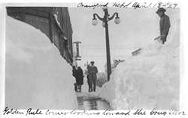 The current exhibit of 13 items highlights some of the snow and winter scenes found in Nebraska Memories. While you may be thinking it’s time to update the images and get rid of snow I want to point out the photo titled Crawford business area, blizzard of 1927. Someone has written the date April 18-’27 on the front of it. Because the snow piles are so high I was curious to know how much snow Crawford received around this time period so I did a few quick searches and located the digitized version of the book Climatological data Nebraska Section, Volumes 24-32 by the National Climatic Center, National Climatic Data Center (U.S.). The climatological date for the month of April 1927 starts on page 15 of this document. While I did not find the total snowfall for Crawford I did find this: “The average for the Northwest Division of the State was 21 inches, which is the greatest April fall in that Division during the 38 years of record.” Going back to page 13 of the same document it shows that the Northwest Division had already received an average of 16.2 inches of snow in March. These numbers could explain the large piles of snow visible in the picture.
The current exhibit of 13 items highlights some of the snow and winter scenes found in Nebraska Memories. While you may be thinking it’s time to update the images and get rid of snow I want to point out the photo titled Crawford business area, blizzard of 1927. Someone has written the date April 18-’27 on the front of it. Because the snow piles are so high I was curious to know how much snow Crawford received around this time period so I did a few quick searches and located the digitized version of the book Climatological data Nebraska Section, Volumes 24-32 by the National Climatic Center, National Climatic Data Center (U.S.). The climatological date for the month of April 1927 starts on page 15 of this document. While I did not find the total snowfall for Crawford I did find this: “The average for the Northwest Division of the State was 21 inches, which is the greatest April fall in that Division during the 38 years of record.” Going back to page 13 of the same document it shows that the Northwest Division had already received an average of 16.2 inches of snow in March. These numbers could explain the large piles of snow visible in the picture.
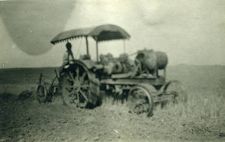 For those of you who have had enough snow don’t worry we are working on a new map exhibit to go up in April. This new exhibit will be snow free. It will include a picture of Grandpa using his “Waterloo” to plow a field, a group of folks celebrating National Air Mail Week
For those of you who have had enough snow don’t worry we are working on a new map exhibit to go up in April. This new exhibit will be snow free. It will include a picture of Grandpa using his “Waterloo” to plow a field, a group of folks celebrating National Air Mail Week  and more than one graduating class. When you see the new exhibit don’t forget all you need to do to learn more about any of the featured photos is to click on the map.
and more than one graduating class. When you see the new exhibit don’t forget all you need to do to learn more about any of the featured photos is to click on the map.
Visit Nebraska Memories to search for or browse through many more historical images digitized from photographs, negatives, postcards, maps, lantern slides, books and other materials.
Nebraska Memories is a cooperative project to digitize Nebraska-related historical and cultural heritage materials and make them available to researchers of all ages via the Internet. Nebraska Memories is brought to you by the Nebraska Library Commission. If your institution is interested in participating in Nebraska Memories, see http://nlc.nebraska.gov/nebraskamemories/participation.aspx for more information, or contact Beth Goble, Historical Projects Librarian, or Devra Dragos, Technology & Access Services Director.
Don’t Forget the Back Part II
 “I suppose you have got my letter. Good Bye. Agnes.” That is all that Agnes had to say to Mr. G. Greanbeam. Agnes sent that short message on the back of a postcard in the early 1900’s. I get the impression that Agnes is leaving a lot unsaid. This is just one of many postcards in Nebraska Memories that intrigue me.
“I suppose you have got my letter. Good Bye. Agnes.” That is all that Agnes had to say to Mr. G. Greanbeam. Agnes sent that short message on the back of a postcard in the early 1900’s. I get the impression that Agnes is leaving a lot unsaid. This is just one of many postcards in Nebraska Memories that intrigue me.
In January of 2012 I wrote a blog post titled Don’t Forget the Back. It’s now two years later and I still like to take the time to read the back of the postcards in Nebraska Memories. I want to share with you some of my recent finds and issue you a challenge.
Reading the backs of these two postcards I’m assume two little girls wrote them. On the back of the postcard featuring the Bryan Hammer Bldg. in Omaha is a short note from Margaret to her grandma asking her how she is. On the other card showing the fountain in the Brandeis Stores Rhoda wrote a note to her Aunt Etta. Rhoda told her that “I am a big girl I love you very much your little girl Rhoda”.
This next postcard of the Methodist Hospital, Omaha, Neb. was never mailed so we have no idea when or who wrote this cleaver saying on the back: “‘Hospital’ Where people who are run down, wind up!”
In October of 1911 someone with the initials CAM wrote to Miss Suzie Mathis in Swanton Nebraska. (For those of you like me who have not visited Swanton it is located about 50 miles south and a bit west of Lincoln.) CAM wanted to let Suzie know that all is well and that Russell had been in the hospital. “He has Varicose Veins in his right leg. 3 Dr’s worked on him 2 1/2 hours & took out 12 ft. of veins. he seems to be doing well but is feeling very sore”. Do you really think she meant 12 feet? I can understand why Russell was a bit sore.
With this last postcard I’d like to issue a challenge to everyone. What private message is Robby sending to his Sweet Heart Miss Blanche Shanklin with all of these letters? Here is the text of the postcard:
Miss Blanche Shanklin
Menlo
IowaGillette wyo April 24-13
Dearest Sweet Heart Thurs noon
this is a beautifull day but looks a little cloudy in the west I dont feel very good today and awful lonesome G.B.Y.D.H.I.D.W.Y.W.A.M.H.&.S.YAAJWTMC I sure will be glad when I start back for Sunny Brook and I don’t think it will be long either I will write when I get to Billings IAYODEJH Robby Pal
What do you think all of those letters mean? Don’t forget that this postcard was written in 1913. Leave a comment with your best guess. Maybe if a number of folks contribute we can decode the message. I don’t want to influence your interpretation of the message so I’m going to wait until next week to leave my best guess in the comments.
Visit Nebraska Memories to search for or browse through many more historical images digitized from photographs, negatives, postcards, maps, lantern slides, books and other materials.
Nebraska Memories is a cooperative project to digitize Nebraska-related historical and cultural heritage materials and make them available to researchers of all ages via the Internet. Nebraska Memories is brought to you by the Nebraska Library Commission. If your institution is interested in participating in Nebraska Memories, see http://nlc.nebraska.gov/nebraskamemories/participation.aspx for more information, or contact Beth Goble, Historical Projects Librarian, or Devra Dragos, Technology & Access Services Director.
Posted in General, Information Resources, Nebraska Memories, Technology
1 Comment
Window Shopping in Nebraska Memories
 With the holiday season just around the corner I thought it would be the perfect time to do a bit of window shopping in Nebraska Memories. While I’m not sure all of the items on display would be the best option for gift giving it is still fun to look.
With the holiday season just around the corner I thought it would be the perfect time to do a bit of window shopping in Nebraska Memories. While I’m not sure all of the items on display would be the best option for gift giving it is still fun to look.
Let’s start our window shopping in Omaha at the S.S. Kresge Store. While I don’t know for sure I believe these two photos of window displays were taken at the Kresge store in downtown Omaha at the corner of 16th and Harney.  The Window display of candy includes candy canes, lollypops, and boxes of candy. The other photo taken at the Kresge Store is of a Kleenex window display. This photo from 1938 shows that Kleenex are good for both the home and the office.
The Window display of candy includes candy canes, lollypops, and boxes of candy. The other photo taken at the Kresge Store is of a Kleenex window display. This photo from 1938 shows that Kleenex are good for both the home and the office.
 It looks like in 1937 grocery stores liked to display their canned goods by stacking them in the form of pyramids. This can be seen in two photos of grocery stores in Omaha. In the picture of the Saratoga Grocery and Meat Co. they are advertising a canned food sale in the window and have many can pyramids on display.
It looks like in 1937 grocery stores liked to display their canned goods by stacking them in the form of pyramids. This can be seen in two photos of grocery stores in Omaha. In the picture of the Saratoga Grocery and Meat Co. they are advertising a canned food sale in the window and have many can pyramids on display.  The I.W. Rosenblatt Food Store also has an impressive display of canned items on display in their window. Their mammoth canned food sale includes peas, corn, apricots, kraut and Pet milk.
The I.W. Rosenblatt Food Store also has an impressive display of canned items on display in their window. Their mammoth canned food sale includes peas, corn, apricots, kraut and Pet milk.
Today the thought of having a one cent sale seems unlikely but in 1931  the Harley Drug located at 1101 O Street in Lincoln had a huge once cent sale. The window display shows numerous items along with two large signs shaped as the number one that appear to list a number of items for sale.
the Harley Drug located at 1101 O Street in Lincoln had a huge once cent sale. The window display shows numerous items along with two large signs shaped as the number one that appear to list a number of items for sale.
The last window on my window shopping trip is that of the Capitol Hardware that was located at 1447 O Street, Lincoln in 1946. Their window is full of Sunbeam electrical appliances. The display includes waffle baker, toaster, Mixmaster, iron (for $9.95), razor (for $15.90). A sign also states that “the Sunbeam Man” will be in the store all day Saturday!
I hope you enjoyed our window shopping trip in Nebraska Memories. We didn’t see all of the window displays today so there are more to see in Nebraska Memories.
Visit Nebraska Memories to search for or browse through many more historical images digitized from photographs, negatives, postcards, maps, lantern slides, books and other materials.
Nebraska Memories is a cooperative project to digitize Nebraska-related historical and cultural heritage materials and make them available to researchers of all ages via the Internet. Nebraska Memories is brought to you by the Nebraska Library Commission. If your institution is interested in participating in Nebraska Memories, see http://nlc.nebraska.gov/nebraskamemories/participation.aspx for more information, or contact Beth Goble, Historical Projects Librarian, or Devra Dragos, Technology & Access Services Director.
Back to College
 It’s that time of year again when students are preparing to head back to college. Looking at the photos of two Union College dorm rooms from the early 1900’s I’m guessing it took those students a lot less time to move into their dorm rooms then it does for students today. This 1907 picture of a Union College dorm room shows two men dressed in suits and ties sitting at a table studying. The room is simply furnished with a bed, table, nigh stand and wardrobe. The wardrobe is covered with knickknacks and photos. A guitar,
It’s that time of year again when students are preparing to head back to college. Looking at the photos of two Union College dorm rooms from the early 1900’s I’m guessing it took those students a lot less time to move into their dorm rooms then it does for students today. This 1907 picture of a Union College dorm room shows two men dressed in suits and ties sitting at a table studying. The room is simply furnished with a bed, table, nigh stand and wardrobe. The wardrobe is covered with knickknacks and photos. A guitar, lute mandolin and banjo are sitting next to the window.  The women’s dorm room in this picture from 1911 or 1912 is also simply furnished with a bed, table and rocking chair. The walls are decorated with variety of pennants. The young woman in the photo is wearing a dress and is standing behind a potted plant.
The women’s dorm room in this picture from 1911 or 1912 is also simply furnished with a bed, table and rocking chair. The walls are decorated with variety of pennants. The young woman in the photo is wearing a dress and is standing behind a potted plant.
I find it interesting to look at the different styles of buildings that were used as dormitories and how they differ from campus to campus and have changed over the years. The photo of Green Terrace Hall is the oldest photo of a dormitory included in Nebraska Memories. Green Terrace Hall was a women’s dormitory at Nebraska State Normal School at Kearney.  The picture is dated July 10, 1903 and shows a large building that contained 74 rooms, 16 halls, 40 closets, 6 bathrooms, 4 toilet rooms with basins, 8 water closets and 4 kitchen sinks. According to the note included in the record this dorm earned the nickname of “Cockroach Castle” sometime before it was demolished in 1959-1960.
The picture is dated July 10, 1903 and shows a large building that contained 74 rooms, 16 halls, 40 closets, 6 bathrooms, 4 toilet rooms with basins, 8 water closets and 4 kitchen sinks. According to the note included in the record this dorm earned the nickname of “Cockroach Castle” sometime before it was demolished in 1959-1960.
 East Hall and South Hall were located on the campus of Union College in 1911-1912. I think both of these dorms had a bit more of a homey look to them because of the large covered front porches on both structures. Like the Green Terrace Hall the East Hall also received a couple of nicknames over the years.
East Hall and South Hall were located on the campus of Union College in 1911-1912. I think both of these dorms had a bit more of a homey look to them because of the large covered front porches on both structures. Like the Green Terrace Hall the East Hall also received a couple of nicknames over the years. The students living in the dorm called it the “White House” while other students referred to it as the “Cracker Box.”
The students living in the dorm called it the “White House” while other students referred to it as the “Cracker Box.”
The first high-rise residences hall that was built on Wayne State College’s campus was built in 1965. In this picture you can see Bowen Hall during the construction process. According to Wayne State College’s website Bowen Hall is still being used today as a residence hall. The most recent photo of a dormitory that can be found in Nebraska Memories is that of Centennial Hall. Centennial Hall is located on campus of Nebraska Wesleyan University. The photo was taken sometime between 1967 and 1971. According the Nebraska Wesleyan’s website Bowen Hall is also still being used today.
Visit Nebraska Memories to search for or browse through many more historical images digitized from photographs, negatives, postcards, maps, lantern slides, books and other materials.
Nebraska Memories is a cooperative project to digitize Nebraska-related historical and cultural heritage materials and make them available to researchers of all ages via the Internet. Nebraska Memories is brought to you by the Nebraska Library Commission. If your institution is interested in participating in Nebraska Memories, see http://nlc.nebraska.gov/nebraskamemories/participation.aspx for more information, or contact Beth Goble, Historical Projects Librarian, or Devra Dragos, Technology & Access Services Director.
Posted in General, Information Resources, Nebraska Memories, Technology
2 Comments
Nebraska – 125 Years Ago
Recently I was browsing the Nebraska Memories website and ran across a photo of Omaha taken from the intersection of Center Street near 40th Street. The date of the photo was 1888. I did a bit of searching in Nebraska Memories and was pleasantly surprised with the variety of items all from 1888. Here are a few items that made an impression on me.
 Let’s start in the panhandle with a picture of Crawford. The picture appears to be showing main street or business area of town. Reading the note included with the picture I learned that sometime in the future most of the wooden buildings on the right side of the photo were destroyed in a fire. It’s hard to imagine how devastating of a loss that would be for the town.
Let’s start in the panhandle with a picture of Crawford. The picture appears to be showing main street or business area of town. Reading the note included with the picture I learned that sometime in the future most of the wooden buildings on the right side of the photo were destroyed in a fire. It’s hard to imagine how devastating of a loss that would be for the town.
Unfortunately the next stop in Fillmore County also isn’t very cheerful. On January 12, 1888 a bad blizzard hit the Great Plains. There are no pictures of the blizzard but there is a book in Nebraska Memories documenting the 50th anniversary of the blizzard. You can learn more about the blizzard and this book in Blizzard Reunion blog post.
 Let’s move on to a happier occasion and look at the program from the Lincoln May Music Festival that was held at the First Congregational Church in Lincoln on May 14-16, 1888. At first this may not sound that interesting unless you are a music lover but I was surprised with all of the interesting things I learned looking at the program. As you expect there is great information about the concerts and performers but you will also ads from local businesses. Looking at the program I learned:
Let’s move on to a happier occasion and look at the program from the Lincoln May Music Festival that was held at the First Congregational Church in Lincoln on May 14-16, 1888. At first this may not sound that interesting unless you are a music lover but I was surprised with all of the interesting things I learned looking at the program. As you expect there is great information about the concerts and performers but you will also ads from local businesses. Looking at the program I learned:
- It would have cost your 50 cents to attend the festival or you could have purchased season tickets for $1.25.
- At the festival they performed Judas Maccabaeus composed by George Frederic Handel and The Holy City by A. R. Gaul.
- J. E. Miller advertised “Best Quality Body Brussels Carpet” for $1.05 per yard. The ad didn’t mention installation.
- A single meal at the Odell’s Dinning Hall would cost you 25 cents or you could pay $4.50 per week.
- The ad for “Leavitt’s Domestic” does not say what they are selling. Based on the picture and wording I’m guessing its coal. Whatever it is will cost you $7.65 delivered and it “Burns to Clean Ash. – Makes no Soot nor Clinker.”
- Folks saving their money at the Union Savings Bank they would receive interest. “Paid depositors at the rate of Five per cent per annum on all deposits exceeding $5.00 and under $3,000.00, for all full calendar months such deposit is in bank. Interest payable semi-annually.”
 Let me end this tour of with the some photos of Omaha taken in 1888 by William Wallace. I’ve included links to the 1888 photos along with links to Google Street views of approximately the same location.
Let me end this tour of with the some photos of Omaha taken in 1888 by William Wallace. I’ve included links to the 1888 photos along with links to Google Street views of approximately the same location.
- Woolworth Avenue, looking east from Georgia Avenue
(Georgia Avenue is now 29th Street)
Google Street View - Corner of Georgia Avenue and Woolworth Avenue, looking northeast
Google Street View - Street grading on Center Street near 40th Street
If you haven’t heard of the street grading projects make sure you check out Emily’s blog post on Re-Shaping Omaha.
Google Street View
Visit Nebraska Memories to search for or browse through many more historical images digitized from photographs, negatives, postcards, maps, lantern slides, books and other materials.
Nebraska Memories is a cooperative project to digitize Nebraska-related historical and cultural heritage materials and make them available to researchers of all ages via the Internet. Nebraska Memories is brought to you by the Nebraska Library Commission. If your institution is interested in participating in Nebraska Memories, see http://nlc.nebraska.gov/nebraskamemories/participation.aspx for more information, or contact Beth Goble, Historical Projects Librarian, or Devra Dragos, Technology & Access Services Director.
Three Carnegie Libraries
As National Library Week comes to an end I wanted to highlight a few of the sixty plus Carnegie libraries that were built across Nebraska. When talking about Carnegie libraries I’m referring to those libraries built with the help of Andrew Carnegie. According to information on the Library of Congress’s website Carnegie helped to build over 2,500 libraries worldwide. You may also recognize his name in connection with the Carnegie Hall and Carnegie Mellon University.

- Chadron Public Library
The first building I want to highlight is the Chadron Public Library. The bulding is located at 507 Bordeaux St in Chadron as is still the current home of the Chadron Public Library. The building was designed by George Berlinghof of Lincoln who received $100 for the architectural plans. The building was completed in 1911. Comparing the photo of the library in Nebraska Memories taken sometime in the 1920’s to a more recent photo taken in 2006 you can see the front of the building is relatively unchanged. The most noticeable change is the removal of the decorative windows. According to the National Register of Historic Places Registration Form these windows were removed in 1964 as part of effort to make the building more energy efficient.

- Gothenburg Public Library
Let’s head a bit southeast and look at the Gothenburg Public Library. The library is located at 1104 Lake Ave in Gothenburg. This Carnegie library was completed in 1916. Comparing the recent photo and the historical photo you can see that an addition was added that mimics the lines of the original building.
For our last stop let’s look at the Fairbury Public Library. The library is located at the corner of 7th and F Street. Carnegie donated $12,500 for the library which was built on a lot purchased by the city for $2,500. The building was designed by Tyler and Son of Lincoln. It opened to the public in December of 1909 and is still being used today.
As I was researching the Fairbury Carnegie building I found an article in the 1908 North Platte semi-weekly tribune that mentioned that the town of Fairbury was asking Mr. Carnegie for additional funds. The article also stated: “They Library will be practically a duplicate of the one at Kearney.”
Comparing the historical images of the Fairbury Public Library and the Kearney Public Library I was surprised to see how similar they looked on the outside. Unfortunately we can’t compare current photos of the Carnegie buildings because the building in Kearney was torn down in 1975. We can however see what the Adult Reading Room and the Children’s Room looked like in the Kearney Carnegie building in the 1920’s.
Visit Nebraska Memories to search for or browse through many more historical images digitized from photographs, negatives, postcards, maps, lantern slides, books and other materials.
Nebraska Memories is a cooperative project to digitize Nebraska-related historical and cultural heritage materials and make them available to researchers of all ages via the Internet. Nebraska Memories is brought to you by the Nebraska Library Commission. If your institution is interested in participating in Nebraska Memories, see http://nlc.nebraska.gov/nebraskamemories/participation.aspx for more information, or contact Beth Goble, Historical Projects Librarian, or Devra Dragos, Technology & Access Services Director.
Posted in General, Information Resources, Nebraska Memories
Leave a comment
Blizzard Reunion
This weekend while reading the paper I ran across an article – “The Blizzard of 1888 — the force of a white hurricane — hit 125 years ago” – about the blizzard of January 12, 1888. The blizzard took many people by surprise because the day started out relatively warm before the storm moved in. The storm hit while many children were at school causing many students to be stranded at school or they struggled to get home during the storm. Because of these struggles the blizzard became known as the Children’s Blizzard. Across the Great Plains 235 people, including a number of children, perished in the storm.
 On January 12, 1938, fifty years after the blizzard, students of the Fairview School, in Fillmore County, Nebraska got together for a reunion. A record of the reunion can be found in the self-published book: Blizzards: reunion and fiftieth anniversary, 1888-1938. The complete text of this book is available in Nebraska Memories at: http://memories.ne.gov/u?/hpl,0
On January 12, 1938, fifty years after the blizzard, students of the Fairview School, in Fillmore County, Nebraska got together for a reunion. A record of the reunion can be found in the self-published book: Blizzards: reunion and fiftieth anniversary, 1888-1938. The complete text of this book is available in Nebraska Memories at: http://memories.ne.gov/u?/hpl,0
Part of the books contains what is described as “Letters and Life Sketches of Schoolmates”. These are letters written by the former students tell what they remember of the storm an update of what has happened in their lives over the past 50 years. Frank J. Stephenson was the teacher at the Fairview School in 1988. In one of his letters he wrote the following: “… the event of the blizzard I remember in detail. The warm pleasant snow falling to an unusual depth, then about 2 o’clock a noise outside as of rushing animals. A glance at the windows already darkening revealed the cause. Then one window began to give away before the pressure. You boys helped prop a bench against it to hold it in place. Then to overcome panic we had a “Chinese School,” everybody studying at the top of this voice. When we tired of this several of us went out and carried in a vast store of coal to last the night. Then two farmers drove their teams to the school house for most of the children, and I know I spent the night at August Stalldorf’s near the corner…. I recall that my sister tied her pupils together and led them to a nearby farm house.”
To read this book or learn more about Nebraska’s history visit Nebraska Memories and search for or browse through many more historical images digitized from photographs, negatives, postcards, maps, lantern slides, books and other materials.
Nebraska Memories is a cooperative project to digitize Nebraska-related historical and cultural heritage materials and make them available to researchers of all ages via the Internet. Nebraska Memories is brought to you by the Nebraska Library Commission. If your institution is interested in participating in Nebraska Memories, see http://nlc.nebraska.gov/nebraskamemories/participation.aspx for more information, or contact Beth Goble, Historical Projects Librarian, or Devra Dragos, Technology & Access Services Director.
Posted in Nebraska Memories
Leave a comment
“And when the votes are counted you will never know they ran”
“And when the votes are counted you will never know they ran”. At least that’s what James Asher Parks wrote back in 1908 in the campaign song “Holding Hands”. Here’s the complete second verse:
“Willie Hearst* and Billy Bryan* tried to play a little game, “Holding hands,” Parker too, and poor old Davis likewise tried to do the same, “Holding hands,” The candidates they’re running all are “three-spots” to a man, And when the votes are counted you will never know they ran, You will find them all a standing just about where they began, “Holding hands!””
 I think Mr. Parks might be correct. I knew who Willie Hearst and Billy Bryan were but I must admit I had no idea who Parker and Davis might be. After a quick search I believe he is referring to Alton B. Parker and Henry G. Davis. Alton Parker ran for president in 1904 and Henry G. Davis was his vice-president candidate. As you may know Parker lost that election to Theodore Roosevelt.
I think Mr. Parks might be correct. I knew who Willie Hearst and Billy Bryan were but I must admit I had no idea who Parker and Davis might be. After a quick search I believe he is referring to Alton B. Parker and Henry G. Davis. Alton Parker ran for president in 1904 and Henry G. Davis was his vice-president candidate. As you may know Parker lost that election to Theodore Roosevelt.
“Holding Hands” is just one of twenty-four songs that appear in “Park’s Republican campaign songs”. This book of scores was written by James Asher Parks who was a famous composer and publisher from York Nebraska. “Holding Hands” can be found on page 25. Many of the other scores in this book made me laugh and others made my cringe. I never realized how nasty politics were in 1904.
As you were reading the lyrics above you may have noticed the asterisks after Hearst’s and Bryan’s names. Asterisks like these appear throughout this book. The footnote that goes along with these asterisk states: “Use name of any Democrat desired.” Mr. Parks included an announcement at the front of the book letting folks know that because of the “early demand for Campaign music” these songs were written before the presidential candidates were officially announced. He went on to say that any candidates name could be substituted and “As a rule, any name of two syllables will serve the purpose.” He also stated that folks should “Commit the words and music to memory before rendering and sing with VIM and VIGOR.”
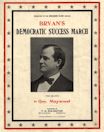 The song “Holding Hands” was clearly a song for the opponents of William Bryan to sing. To be fair I also wanted to point out two scores that support William Bryan. The first one is “Bryan’s Democratic success march” written by George Maywood (also known as George Schleiffarth). Unfortunately there’s not much to say about this score since it has no lyrics. The other song written in support of Bryan is called “Line up for Bryan”. It was written by Nebraska Lawyer and politician George W. Gale. This song does include lyrics.
The song “Holding Hands” was clearly a song for the opponents of William Bryan to sing. To be fair I also wanted to point out two scores that support William Bryan. The first one is “Bryan’s Democratic success march” written by George Maywood (also known as George Schleiffarth). Unfortunately there’s not much to say about this score since it has no lyrics. The other song written in support of Bryan is called “Line up for Bryan”. It was written by Nebraska Lawyer and politician George W. Gale. This song does include lyrics.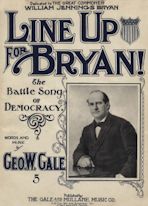
“We are marching on to victory There’s music in the air, We’ll place our gallant leader in the presidential chair We are ready for the battle now we’re waiting for the day We’ll fall in line for Bryan boys Hip Hip Hooray.”
I hope you enjoyed this break from modern day politics and were amused by politics of the past. Do you think after the votes are counted and a hundred or so years pass that folks will remember who ran and lost today’s election?
Visit Nebraska Memories to search for or browse through many more historical images digitized from photographs, negatives, postcards, maps, lantern slides, books and other materials.
Nebraska Memories is a cooperative project to digitize Nebraska-related historical and cultural heritage materials and make them available to researchers of all ages via the Internet. Nebraska Memories is brought to you by the Nebraska Library Commission. If your institution is interested in participating in Nebraska Memories, see http://nlc.nebraska.gov/nebraskamemories/participation.aspx for more information, or contact Beth Goble, Historical Projects Librarian, or Devra Dragos, Technology & Access Services Director.
Looking at the Details
 When looking at photos in Nebraska Memories I think it’s important to spend a few minutes looking at the details of a photo. You never know what you may spot. I’ve spotted a few things that made me want to know more. For example go look at this photo of a Group of women standing next to a bookmobile.
When looking at photos in Nebraska Memories I think it’s important to spend a few minutes looking at the details of a photo. You never know what you may spot. I’ve spotted a few things that made me want to know more. For example go look at this photo of a Group of women standing next to a bookmobile.
It’s easy to see that this photo was taken in 1937 at the district library meeting. It looks like all of the women have on coats, hats and gloves. Most of them are holding some type of purse. Did you happen to notice the logo above the license plate? The first time I looked at the details of this photo I was surprised to see the AAA logo on the back of the bookmobile. To be fair I’ve never given the history of AAA much thought but I was surprised to see they were around in 1937. Looking at the AAA website I soon realized I shouldn’t have been surprised. The American Automobile Association was formed in 1902 and introduced services to stranded motorists in 1915. By the time this photo was taken AAA had already been helping stranded motorists for 22 years! I guess I’ll need to start looking at older photos to see if I can find any earlier photos of the logo.
 Here’s another photo for you. This photo of the Wilson Flower Shop is from 1950. Can you spot the logo that I was surprised to see on the door of the delivery truck? Do you recognize FTD Mercury Man? A quick look at the FTD website and I learned that the Florists’ Telegraph Delivery was formed in 1910 and they have been using the Mercury Man logo since 1914.
Here’s another photo for you. This photo of the Wilson Flower Shop is from 1950. Can you spot the logo that I was surprised to see on the door of the delivery truck? Do you recognize FTD Mercury Man? A quick look at the FTD website and I learned that the Florists’ Telegraph Delivery was formed in 1910 and they have been using the Mercury Man logo since 1914.
 As you can tell I come up with a lot of questions when I start looking at the details in a photo. Did you know gazing balls have been around forever? Saying forever might be going a bit too far but I found multiple sites on the web that say gazing balls date back to Italy in the 13th century. I should note however I’m not sure how reliable these sources are. I can say for sure however that there was a mirrored gazing ball in the garden of the Nye residence in Fremont in 1920-1921. It’s prominently featured in the photo of Ray Julius Nye residence formal gardens.
As you can tell I come up with a lot of questions when I start looking at the details in a photo. Did you know gazing balls have been around forever? Saying forever might be going a bit too far but I found multiple sites on the web that say gazing balls date back to Italy in the 13th century. I should note however I’m not sure how reliable these sources are. I can say for sure however that there was a mirrored gazing ball in the garden of the Nye residence in Fremont in 1920-1921. It’s prominently featured in the photo of Ray Julius Nye residence formal gardens.
Unfortunately for me I can’t easily find satisfying answers. In this photo of the Interior of H. A. Sander Store, Papillion, Nebraska do you see all of the bananas along the left side of the photo?  In 1912 how long and how far did the bananas have to travel to reach Papillion? This photo is 100 years old. How much do you think the price of bananas have changed between then and now?
In 1912 how long and how far did the bananas have to travel to reach Papillion? This photo is 100 years old. How much do you think the price of bananas have changed between then and now?
I’m sure it won’t surprise you to read I have more examples of interesting things I’ve found in photos when I take the time to look at the details but I think I’ll save those for another post. Have you spotted any interesting details that make you want to know more? Leave a reply for me and let me know what you’ve found.
Visit Nebraska Memories to search for or browse through many more historical images digitized from photographs, negatives, postcards, maps, lantern slides, books and other materials.
Nebraska Memories is a cooperative project to digitize Nebraska-related historical and cultural heritage materials and make them available to researchers of all ages via the Internet. Nebraska Memories is brought to you by the Nebraska Library Commission. If your institution is interested in participating in Nebraska Memories, see http://nlc.nebraska.gov/nebraskamemories/participation.aspx for more information, or contact Beth Goble, Government Information Services Director, or Devra Dragos, Technology & Access Services Director.



